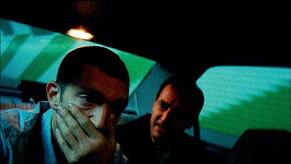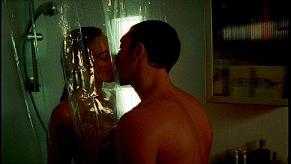Irreversible
Gasper Noé’s
Irréversible doesn’t so much instantly grab you by the throat so much as punch you in the face, leaving your bludgeoned, disoriented and a little queasy, the first sequence forcing one to immediately face the film’s extreme stylization: the camera swoops and swivels in the most unnatural and nausea inducing of axis, all the while the soundtrack is filled with what sounds like low frequency feedback and ambient static. It is not only a perfect mood setter for the following hour or so of one of the most upsetting viewings in years, but the hyper-stylized first scene of the film also hints at the kind of deconstructive cinematic ideas Noé is working at.
Irréversible actually opens with the end credits scrolling backwards and follows them with the swirling, disorientating first scene, telling the story backwards like Memento but with a firm purpose in mind. The film then develops through roughly 10 minute long sections that are slyly edited to look like single takes (and many of them are). With chaotic mise-en-scene, unsettling content, and several interesting ideas behind all the style,
Irréversible packs a wallop that amounts to more than its extreme brutality.
To most, the way Noé stylizes and structures his film will either be secondary to-or a gimmick complimenting-Irréversible’s controversial plotline. After a brief philosophical comment from a sideliner-

“Time destroys all things”-the film’s non-committal camera follows Marcus (Vincent Cassel) as he descends into a gay club called The Rectum. Traveling through deep-red corridors and finding nothing but the most extreme of graphic homosexual behavior, Marcus finds himself in a homophobe’s hell, feverishly trying to hunt down a man hiding in the club. With Marcus is his more timid friend Pierre (Albert Dupontel), but as Marcus goes deeper and deeper into the club, and as the atmosphere gets more claustrophobic and unnervingly sexually explicit, Marcus leaves Pierre behind in his fervor. Finally finding his man, Marcus picks a fight and ends up with a broken arm. To his rescue comes Pierre, who knocks Marcus’ victim down to the floor and precedes to beat him to death with a fire-extinguisher, repeatedly bashing the man’s face in until it is nothing but a quivering hunk of indistinguishable meat. In what looks like (but cleverly is not) one single shot Noé builds the cumulative effect of a descension into hell. It leaves one gasping for air, and all the more wary because Irréversible is infamous not for this beating, but for another sequence altogether.
The Rectum scene raises all the questions that the next hour and a half will resolutely not answer. Understandably the audience has probably already judged the film’s two main characters as violent, irrational and immensely dislikable; but Noé questions if immediate judgment is possible when all that is visible is that act and not the motivation, for it comes to light later that Marcus went to The Rectum because he was searching for the

man who raped and beat his girlfriend Alex (Cassell’s real-life wife, Monica Belucci) until she was in a coma. Does this make Marcus’ revenge right, or at least understandable? Even later it is revealed that Pierre and Marcus targeted the wrong man, but they think they got the right one. In the first conversation in the film a character philosophizes about a crime he was put away for-how it felt great for him to do it, but the authorities said it was wrong-he then concludes that there are no bad deeds, just deeds. This is at the crux of Irréversible, but not so much as a theory to be applied to the real world as it is to cinema. Although the film’s backwards structure initially feels like a gimmick, there is a correlative strategy between Irréversible’s narrative and its structure; it is there to constantly question what the audience thinks and feels about the people on screen. For example, the cornerstone of the film, the infamous single-take rape of Alex, is the first time the audience gets to look at Monica Bellucci. And yet the film never lets the audience identify with Alex as a character nor with Bellucci as a star in the normal sense of the word, merely as an object representing “woman”-Noé purposely shoots the entire scene so that one can never fully see Bellucci-first his camera follows her from behind, then the rapist covers her face to keep her from screaming, and by the end she is so beaten that she cannot be recognized. This is a prime example of Noé’s formal strategy. Besides for asking questions about justifying isolated character actions, Noé is also reflecting on what it takes for the audience to be affected by cinema, how characters and plot events can be combined or isolated and how that can impact a film’s emotional punch. To say that Noé’s film is devastating would be an understatement, but the heart of the matter is why it is so wrenching, what about the way the characters and their formal depiction are represented in film is so affecting.
Irréversible's narrative is admittedly simple once one subtracts its formalism, for Noé is more interested in what his technique can bring to the most basic of material. A strong instance of this is the third level to the film’s backwards structure, an odd combination of stylistic regression and narrative contrivance. As the film steps backwards away from the rape Noé’s camera calms down significantly.

Each sequence is still shot in the single-take fashion, but gone is the gyrating camera, gone is much of the disturbing low frequency noise on the soundtrack, and in their place are far more “normal” compositions of Pierre, Alex, and Marcus chatting. Be it an extended, improvised chat about sex on the subway or the couple’s warm bedroom banter, Noé sedates his style in direct proportion to each scene’s narrative distance from film’s violent first half. Similarly, Noé begins to coat his characters in a sickly sweet gloss that undercuts the brutal, gritty, impressionistic realism of the film’s first half. Marcus and Alex’s relationship regresses from argument to naïve heterosexual perfection, even hinting at the possibility of Alex being pregnant. (There is a strong juxtaposition of the film’s beginning and end, where, respectively, there is the picture perfect ideal of a heterosexual relationship, and then the most degenerate, graphic and disturbing portrayal of homosexual relationships.) Boy loves girl, boy fights with girl, girl gets raped, boy enacts right of vengeance is all but the most exploitive plotline possible, but what Noé does with it is truly remarkable. The film is short, a quick uppercut to the jaw and its over, the darkness fading, and the camera sinking lovingly into Bellucci’s gorgeous summertime glow. But the dreadfulness of the experience remains, as do Noé’s many questions, the prime one being-should I really be talking about formal technique, or am I covering up for the pure visceral quality of the movie’s primeval violence?


0 Comments:
Post a Comment
Subscribe to Post Comments [Atom]
<< Home